Related Research Articles

The Kingdom of Saudi Arabia is a country situated in Southwest Asia, the largest country of Arabia, by the Arabian Peninsula, bordering the Persian Gulf and the Red Sea, north of Yemen. Its extensive coastlines on the Persian Gulf and Red Sea provide great leverage on shipping through the Persian Gulf and the Suez Canal. The kingdom occupies 80% of the Arabian Peninsula. Most of the country's boundaries with the United Arab Emirates (UAE), Oman, and the Republic of Yemen are undefined, so the exact size of the country remains unknown. The Saudi government estimate is at 2,217,949 square kilometres, while other reputable estimates vary between 2,149,690 and 2,240,000 sq. kilometres. Less than 7% of the total area is suitable for cultivation, and in the early 1960s, population distribution varied greatly among the towns of the eastern and western coastal areas, the densely populated interior oases, and the vast, almost empty deserts.
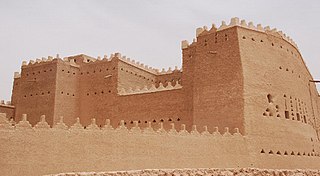
Diriyah, formerly romanized as Dereyeh and Dariyya), is a town in Saudi Arabia located on the north-western outskirts of the Saudi capital, Riyadh. Diriyah was the original home of the Saudi royal family, and served as the capital of the Emirate of Diriyah under the first Saudi dynasty from 1744 to 1818. Today, the town is the seat of the Diriyah Governorate, which also includes the villages of Uyayna, Jubayla, and Al-Ammariyyah, among others, and is part of Ar Riyad Province.

Ad-Dahna Desert is the central division of the Arabian Desert. It is a corridor of sandy terrain forming a bow-like shape that connects an-Nafud desert in the north to Rub' al-Khali desert in the south. Its length is more than 1,000 km (620 mi) siding Twaik Mountains from the east and does not exceed 80 km (50 mi) in width. It is also considered the geographical margin separating Al-Ahsa Province from Najd. Al-Dahna Desert is therefore the string that connects the great deserts of Saudi Arabia.

The Masmak Fort, also called the Masmak Fortress or Masmak Palace, is a clay and mudbrick fort in ad-Dirah, Riyadh, Saudi Arabia. Built in 1865 for prince 'Abdurrahman ibn Sulaiman AlDabaan under the Emirate of Jabal Shammar, The fortress played an integral role in the Unification of Saudi Arabia, with the Battle of Riyadh, one of the most important conflicts of the Saudi unification, taking place in the fort. Since 1995, the fortress has been converted into a museum showcasing one of the most important landmarks of Saudi heritage.

Articles related to Saudi Arabia include:

Al-Muzahmiyya Arabic: المزاحمية) is one of the fastest-growing towns in Riyadh Province, Saudi Arabia. It is located 59 kilometres (37 mi) by road southwest of Riyadh, on the important Riyadh-Mecca Highway. As of the 2004 census it had a population of 24,224 people. It lies in a wide valley known as Wadi Al-Batin, and was founded in the 16th century as a colony of small independent farms and estates that later joined together to form one village. It is currently part of Al-Muzahmiyya Governorate. It's considered the west gate of the capital city of Saudi Arabia Riyadh

Jabal Tuwaiq is a narrow escarpment that cuts through the plateau of Najd in central Arabia, running approximately 800 km (500 mi) from the southern border of Al-Qasim in the north, to the northern edge of the Empty Quarter desert near Wadi ad-Dawasir in the south. It is 600 m (2,000 ft) high and also has a Middle Jurassic stratigraphic section. The eastern side slopes downwards gradually, while the western side ends in an abrupt manner. The escarpment can be thought of as a narrow plateau, though the locals refer to it as a jebel ("mount"). Marshall Cavendish used the name "Tuwayr Mountains" to describe mountains of central Arabia, distinct from the Shammar in the north, the Dhofar in the south, and the Hajar to the east.

Hafar al-Batin, also frequently spelled Hafr al-Batin, is a Saudi Arabian city in the Eastern Province. It is located 430 km north of Riyadh, 94.2 km from the Kuwait border, and about 74.3 from the Iraq border. The city lies in the dry valley of the Wadi al-Batin, which is part of the longer valley of the river Wadi al-Rummah, which leads inland toward Medina and formerly emptied into the Persian Gulf.
Hotat Bani Tamim is a Saudi Arabian town, adjacent to Riyadh. Its population is about 40,000. Most of the residents are from the Tamimi tribe. Hotat Bani Tamim is located 135 km south of Riyadh's southern ring road, and slightly northeast of the Ibex Reserve Protected Area.
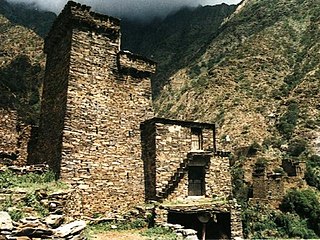
Saudi Arabia is the second biggest tourist destination in the Middle East with over 16 million visiting in 2017. Although most tourism in Saudi Arabia still largely involves religious pilgrimages, there is growth in the leisure tourism sector. As the tourism sector has been largely boosted lately, the sector is expected to be the white oil for Saudi Arabia. This is proved as tourism sector is expected to generate $25 billion in 2019. Potential tourist areas include the Hijaz and Sarawat Mountains, Red Sea diving and a number of ancient ruins.
Thumamah Airport is an airport located near ath-Thumamah in northeastern Riyadh, Saudi Arabia. It is located about 28.9 km (18 mi) north of King Khalid International Airport.

The National Museum of Saudi Arabia is a major national museum in Riyadh, Saudi Arabia. Established in 1999, it is part of the King Abdulaziz Historical Centre in Riyadh.
British International School Riyadh (BISR) is an international co-educational school located in Riyadh, Saudi Arabia. It caters to English-speaking boys and girls aged 3–18 and follows the National Curriculum of the United Kingdom.

Prince Sultan Military Medical City (PSMMC) also known as Riyadh Armed Forces Hospital is located in Riyadh City, the capital of Saudi Arabia, considered one of the most advanced centres in the Middle East. It is located in the heart of Riyadh. At a distance of approximately 20 kilometres (12 mi) from the city centre and easily accessible to the general population. PSMMC is part of the Medical Services Department (MSD) of the Ministry of Defense (MOD).
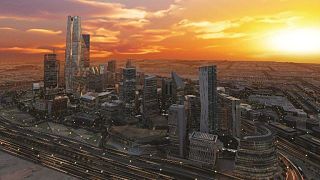
The King Abdullah Financial District (KAFD) is a new development under construction near King Fahad Road in the Al Aqeeq area of Riyadh, Saudi Arabia being undertaken by King Abdullah Financial District Development and management Company which is wholly owned by Public Investment Fund (PIF) of Kingdom of Saudi Arabia. Previously it was being managed by the Rayadah Investment Corporation on behalf of the Pension Authority of the Kingdom of Saudi Arabia.
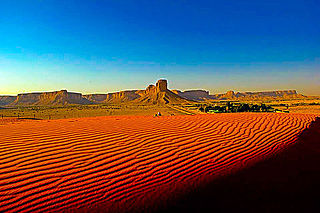
Red Sand is an area of red desert sand dunes near Riyadh, Saudi Arabia.
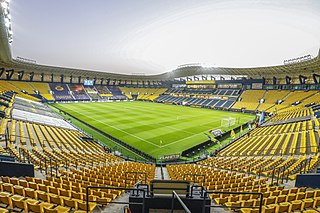
King Saud University Stadium, also known as Mrsool Park due to sponsorship reasons, is a football stadium located in Riyadh, Saudi Arabia. In September 2020, Saudi Media Company obtained the management rights for operating the stadium. In October 2020, SMC signed a deal with Al Nassr FC for the Mrsool Park to become their home.
Qiddiya is an entertainment megaproject to be established in Riyadh. Construction started in the beginning of 2019. The project is one of the tourism megaprojects to be established in Saudi Arabia under the auspices of Saudi Vision 2030, which aims to diversify the income resources of the country and alleviate its reliance on oil. On 26 June 2019, the master plan for Qiddiya was revealed, composed of five primary projects. These projects include resorts, parks, and a city center. Phase one, slated to be completed in 2023, will feature "Six Flags Qiddiya" as a family attraction.

Riyadh Zoo, formerly Riyadh Zoological Gardens and locally as Malaz Zoo, is a 55-acre zoo in al-Malazz, Riyadh, Saudi Arabia. Founded in 1957 as private menagerie for King Saud and the Saudi royal family, the zoo was opened to the public in 1987 and it's today home to more than 1,500 animals of around 196 different species, including endangered ones. It is the largest and one of the oldest zoos in Saudi Arabia.
Al-Thumamah, alternatively spelt as Al-Thumama and pronounced as ath-Thumamah, is a sand desert area in the northeastern fringes of Riyadh, Saudi Arabia. It is located approximately 50 miles from Riyadh and is popular amongst residents, especially trekkers and campers for outdoor recreation. The archaeological excavations in the area trace the settlement's early existence to almost 8000 years during the Neolithic period. It's first census was conducted in 1981 during the reign of King Khalid.
References
- ↑ "Thumamah National Park". Travellingfoot. Retrieved 27 June 2021.
- ↑ "متنزه الثمامة بالصور". المرسال (in Arabic). Retrieved 2022-08-27.